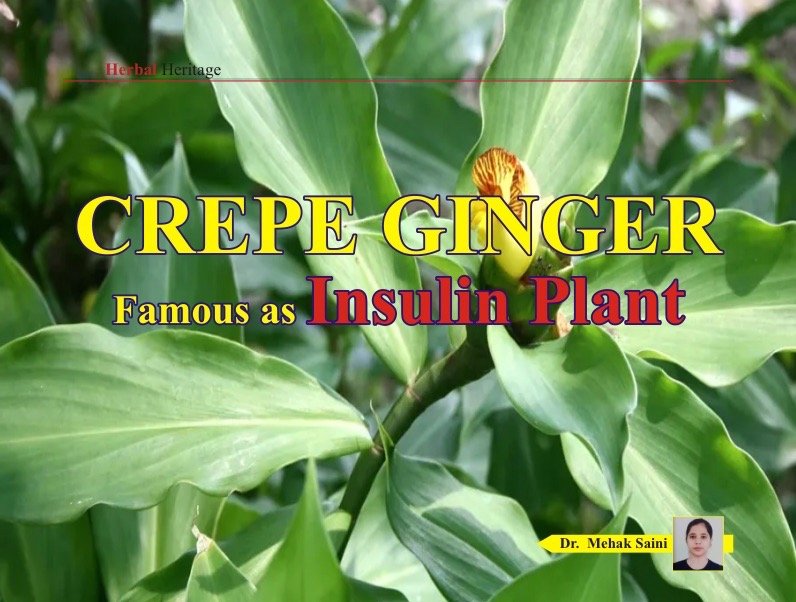Leaves of Crepe ginger are used as a dietary supplement in the treatment of diabetes mellitus, hence commonly known as ‘Insulin Plant’.
Costus speciosus also known as Crepe ginger and Kembu is a widely cultivated ornamental plant. It is native to Southeast Asia & surrounding regions from India to China.
The plant is propagated only through rhizome cuttings. The rhizome pieces are placed at a depth of 8-10 cm and covered with soil. The crop is irrigated immediately after planting. The thick sized pieces sprout slowly after 40-45 days of planting due to the eyebuds being dormant on these rhizome pieces which take a longer time to develop. After 70-75 days, about 90-95% sprouting is obtained.
Leaves are spirally arranged and have attractive flowers. This species reproduces vegetatively by rhizome.
Leaves are used as a dietary supplement in the treatment of diabetes mellitus hence commonly known as ‘Insulin Plant’. It is also used by tribal people of Kolli hills of Namakkal district , Tamil Nadu to treat diabetes. In Mexican folk medicine, the aerial part of this plant is used as an infusion in treatment of renal disorders.
How to consume?
The leaves of insulin plant can be consumed raw or in powder form.
Raw
Patient has to chew down the leaf for about a month to see positive effects. Take 2 leaves per day in the morning and evening for 1 week. Then after 1 week, take 1 leaf each in morning & evening.
Powder
One can also get the benefits of this plant by drying the leaves & powdering them. Collect the leaves of this plant, wash with water and dry them in shade. After that, grind the dried leaves. The resulting powder can be consumed daily. Ingest one tablespoon of this powder daily.
If any person is on medication for type 2 diabetes, consult the doctor before taking insulin leaves.
Phytoconstituents
Contains various phytochemicals such as tannins, saponins, flavonoids, quinones, glycosides, terpenoids, phenol and alkaloids.
Ayurvedic Perspective
In Ayurveda, insulin plant is called as Kebuka. It is mentioned in various ayurvedic books such as Charaka Samhita, Bhavprakash Nighantu etc.
Indications
Diabetes, cough, pyrexia and leprosy.
Ayurvedic Formulations
Nisosiradi tailam, Asana eladitaila, Brihata Purna Chandra rasa.
Part used
Leaf
Dosage
Powder – 3-6g and Juice – 10-20ml
Role In Diabetes
The leaves are major part of insulin plant which produce significant anti-diabetic activity. These help in reducing fasting as well as post prandial blood glucose levels. This induces hypoglycemia by enhancing insulin sensitivity in cells, stimulating insulin production in the pancreas & demonstrating glucose absorption in the gut. The disogenin present in the leaves is utilized as an anti-diabetic medication.
It also reduces the diabetic associated complications; brings renal, hepatic parameters to a controlled level, decreases the amount of glycosylated haemoglobin, corrects lipid profile, increases body weight as well as insulin levels. Leaf performs all the above actions as it is a rich source of anti-oxidants like tannins, xanthones, flavonoids derived from this plant. Leaf extract from this plant shows significant recovery to restore brain complications induced by hyperglycemic effect & rescue the brain tissue by restoring the number of astrocytes & glial cells.
VPO Bhorath Qazi Chak,
Dinanagar, Distt. Gurdaspur.
sainimehak4@gmail.com







 Dec 2024
Dec 2024
 May 2024
May 2024
 September 2022
September 2022
 April 2022
April 2022
 October 2020
October 2020
 Jan 2020
Jan 2020
 June 2019
June 2019
 January-February 2019
January-February 2019
 Augest-September
Augest-September
 April 2018
April 2018
 November 2017
November 2017
 June 2017
June 2017
 November 2016
November 2016
 September 2015
September 2015
 March 2015
March 2015
 July 2014
July 2014
 January 2014
January 2014
 July2013
July2013
 March 2013
March 2013
 May 2012
May 2012
 May 2011
May 2011
 Sep 2010
Sep 2010
 Jun 2010
Jun 2010
 Feb 2010
Feb 2010
 December 2009
December 2009
 August 2009
August 2009
 June 2009
June 2009
 Feb 2009
Feb 2009
 December 2008
December 2008
 October 2008
October 2008
 March 2008
March 2008
 July 2008
July 2008
 May 2008
May 2008